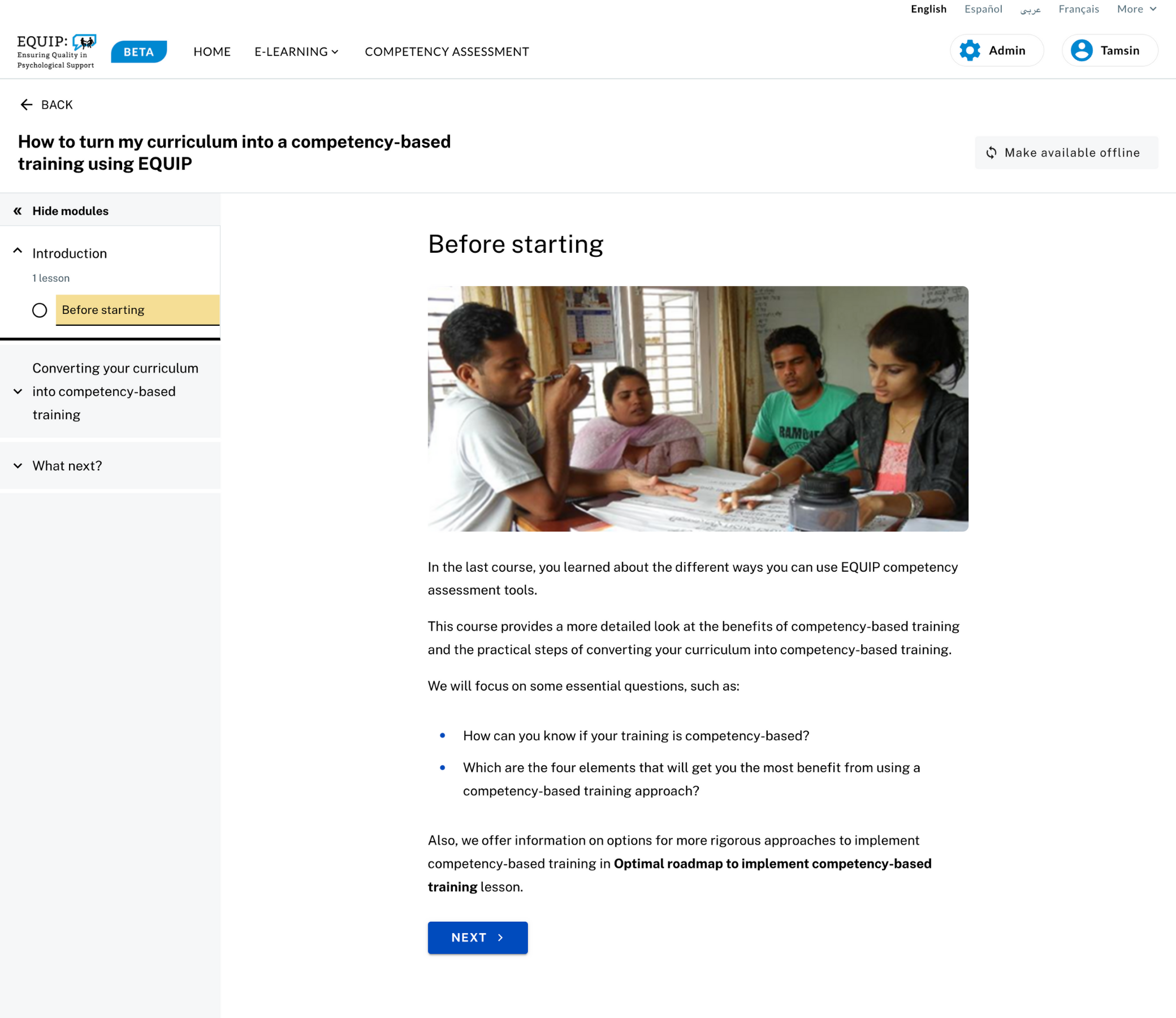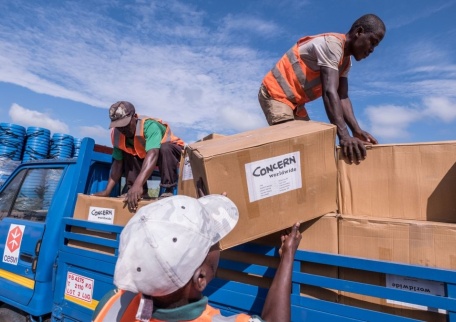Putting in-person competency-based training online for the World Health Organisation
The World Health Organisation needed a way to deliver mental health training and assessments online in areas with intermittent connectivity. We were brought in to turn the EQUIP methodology into a web-based course delivered to 1,500 active weekly users.
Problem
EQUIP (Ensuring Quality in Psychosocial Support) is a current World Health Organisation (WHO) project that helps scale psychological and psychosocial support interventions in middle and low-income settings. The methodology already existed on paper, but WHO and their academic partners at George Washington University were finding it challenging to drive uniform adoption of the training method across the eight partners for the project. Consequently, they decided to bring the training and assessments online.
EQUIP is a partnership between WHO George Washington University and partly funded by USAID. Additional implementation partners include War Child, Health Right International, The Center for Victims of Torture, University of Washington, Socios En Salud, University of South Florida, Cities Rise, University of New South Wales, The Insititute for Family Health, Johns Hopkins University and the Noor Al Hussein Foundation Institute for Family Health.
Our role was to deliver the learning management system (LMS) and assessment tool for mental health and psychosocial support specialists, and eventually helpers (volunteer support workers), as everything was based on delivering supervision and care face-to-face.
Due to the COVID-19 pandemic occurring whilst the project was underway, we had to adjust and adapt to fulfill new needs - ultimately creating a separate resource for anyone adjusting to remote mental health support (learn more about that here).
Once we’d dealt with the COVID-specific problems being faced by the EQUIP team, we needed to pick up the main focus of the project again to meet growing demand from more countries who wanted to use the EQUIP methodology.
Our success criteria included:
- Easy and engaging LMS material for learners
- Excellent usability on low spec mobile and tablet
- Multiple language compatibility (inc. right-to-left scripts)
- Robust editorial workflows, particularly for content in translation
- A fully digital assessment tool that could fully function offline
- Positive adoption metrics and user statistics
Solution
Our online tool for WHO EQUIP achieved over 1,000 users in its first month, and now has over 1,500 active weekly users in 29 different countries, and multiple languages.
We prioritised the following digital elements to scale the EQUIP training method:
- Helping trainers learn the training methodology online
- Giving trainers the digital tools to allow them to train helpers successfully in the field, at scale and offline
- Supplying the organisations with relevant data and visualisation of data during and after trainings
SystemSeed has been an outstanding partner to the EQUIP project and produced on time and to budget all expected deliverables.
Challenges
The EQUIP team had already seen the value of their paper-based tool, but they were well aware that this could not scale without a digital platform. An essential element of EQUIP’s competency-based training is for trainers to assess their trainees whilst watching them carry out role-plays that imitate real client situations. It was essential that assessments could be carried out quickly on low-spec android tablets, even when fully offline.
The organisation’s programme managers needed access to comprehensive and reliable data to share with the rest of the organisation. They needed the assessment tool to be available translated and culturally adapted to their field environments.
EQUIP competency-based training is a different way to train than most trainers in organisations are currently teaching. The implementing partners are already well-versed in this method of training but in order to scale it is important that trainers in many organisations globally are aware of how to use this training approach.
We needed to create useful content that can be used easily offline or in poor wifi settings. The platform needed to encompass different learning styles whilst maintaining engagement and motivation to learn through the EQUIP courses.
How we did it
ANU LMS simplicity and flexibility
All of the courses were to be delivered using a tailored version of ANU LMS, our Drupal-based LMS distribution. ANU has been designed to be simple to use, powerful, and adaptable to different needs.
Agile approach & prioritisation
As a highly agile organisation ourselves, our team members were able to push the pace of development and release an MVP quickly for WHO EQUIP. It’s a normal part of our day-to-day work to prioritise, re-prioritise, and focus on delivering user-focused functionality, so even dramatic project pivots are relatively easy for us to take on.
Early focus on users and prototyping
Because of the extensive work on prototyping and user testing already carried out by the project team, they were able to make decisions quickly and we were able to implement them using ANU. This included helping the academic team members to focus on delivering user-focused content, specifically for online delivery, which is very different from an academic paper.
Through thorough testing in the field we helped to adjust the way assessments were scored to increase the reliability across assessment scores. We prioritised data visualisation that is most important to the organisations to both give trainees feedback and to give full visibility to how their trainings are progressing and improving.
Competency Assessment Application Tool
Our assessment tool offers competency-based assessments through role-play, rating, and analysis. By logging into the assessment tool application, a trainer can select a trainee, their skill level (1-4), and rate them based on their ability to demonstrate 15 key competencies, including non-verbal communication and collaborative goal setting with their future clients.
The trainee is paired with an actor virtually or in person. The actor then reads from a script prompting the trainee to respond as if it were a real session, whilst the rater observes the interaction and rates the trainees' skills and competencies on the app. After 10 minutes, the role-play ends, and the rater submits the assessment to be reviewed by a supervisor and trainee.
Before implementing our cutting-edge application, the tracking and sharing information for trainees was inefficient and led to administrative challenges. Now, results are stored as organized data, then shared and downloaded instantly to provide feedback and help trainees improve their skills. The assessment tool is integrated with our ANU learning management system, allowing trainees and trainers to access online/offline courses that further educate and develop their skills in psychological support and competency-based assessments.
The assessment tool is primarily used on tablets, but can be accessed using both desktop and mobile. It also works offline, whilst easily downloadable on desktop, behaving like any regular mobile app.
Multilingual content and interface
The WHO EQUIP digital platform prioritises diverse multilingual accessibility, from courses to assessment tools, the project is constantly growing it's learning content. Translations are in demand in many languages, beyond the five WHO official languages. We have customised the admin system to make this simple for translators and administrators to manage.
We set up the EQUIP site for multilingual content (including right-to-left languages) relatively quickly. However, translation itself can be time consuming and complex, with various team members needed for translation, review and publication.
We often work with clients who need to allow relevant team members to input translations, and have colleagues be able to review the adapted language used before publication. This can mean various users entering the CMS at one time. We have created processes for EQUIP that allow this to be handled efficiently and securely.
Multiple user types
The EQUIP digital interface has many administrator user types in addition to their front end users. We created a simple process for all administrators that always included the following elements:
- Initial in-person training (remote)
- Support contact details (chat and email) and transparency on available hours
- Training documentation with clear visuals and directions
- Training videos
Outcome
Word of mouth quickly spread even without an official launch, and use of the online courses increased to 1,000 users in our first month.
Through surveys and user interviews we have continued to improve the current courses as well as adding new content. The courses are now being translated into five languages, by project translators who we have helped to train and support.
Now, 8 implementing partners are regularly using the EQUIP digital platform in their trainings in the field, and 1,500 weekly active users are learning through the EQUIP courses, in over 60 different countries.









